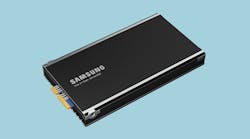Samsung Brings More Smarts to Computational Storage with AMD
This article is part of Electronic Design's coverage of the 2022 Flash Memory Summit.
Samsung Electronics is further bridging the gap between compute and storage with its second-generation SmartSSD.
The first-generation SSD was introduced in late 2020. Paired with flash storage was a Xilinx-designed Kintex FPGA that unloaded storage-related computation from the server’s CPU, reducing power and latency alike.
Samsung said it is upgrading its second-generation SmartSSD with AMD’s Xilinx Versal ACAP to reduce the power consumed by the host system by up to 70% and CPU utilization by up to 97% compared to traditional SSDs.
The AMD-Samsung hardware falls into the category of computational storage devices (CSDs), which offload the CPU in the server by running repetitive storage computations such as compression or encryption locally.
Most of these CSDs come in the form of an SSD, where CPUs, FPGAs, or other types of accelerators are embedded in the same package as the memory controller. That way, they can directly access data stored in NAND flash storage. As the amount of data stashed in a data center’s storage continues to rise, the time it takes to haul data to the CPU at the heart of a server is dragging on performance at the system level.
Computational storage crunches data as close as possible to where it’s stored instead of moving masses of it over networks to a server, accelerating workloads including video transcoding or real-time analytics.
Samsung said the new SmartSSD pays dividends in areas such as artificial intelligence (AI) and 5G networks. According to the company, the new storage hardware can reduce the time it takes to process a request to retrieve data from a database by more than 50%.
Upgrading the Insides
From the outside, the first-generation SmartSSD was virtually identical to any standard Samsung NVMe SSD.
But on the inside, the Xilinx Kintex FPGA had direct access to 4 TB of NAND flash storage and 4 GB of SDRAM, plus a Samsung-designed flash-memory controller, with everything packed in a standard U.2 form factor.
With the FPGA placed in close physical proximity to the storage, the SmartSSD could run storage-related computations itself, reducing the amount of data that must move from storage to the compute plane.
The second generation of the SmartSSD is powered by the VM1802, which belongs to AMD’s Xilinx Versal Prime ACAP family. The programmable SoC is packaged with Samsung’s NAND flash in a compact E3 module.
Versal is a family of heterogeneous compute platforms that unite scalar engines (Arm CPU cores), intelligent engines (DSPs), advanced SerDes for high-end networking, and the same breed of programmable logic at the heart of its FPGAs. The building blocks share the same SoC with hard cores for connectivity and security. One of the primary differences with Xilinx’s SoCs is a network-on-chip (NoC) that ties everything together.
The Versal Prime chip at the heart of the SmartSSD comes packed with dual-core Arm Cortex-A72 CPUs and dual-core real-time Cortex-R5 CPUs. It delivers double the programmable logic as existing Xilinx MPSoCs.
Based on 7-nm process technology, the Versal processor features four lanes of PCIe Gen 4 that double the data rate of PCIe Gen 3. To assist with storage acceleration, the chip also supports 100 GbE of networking.
The combination of Arm cores, programmable logic, and high-speed networking gives the SmartSSD more smarts. Versal can offload entire storage-related workloads instead of having to share the load with a CPU.
The Future of Flash?
Samsung said it rolled out the first-generation SmartSSD to video communications platform vendors and other firms. The second-generation CSD uses software and intellectual property (IP) developed by them.
“With the upgraded processing functionality of the second-generation SmartSSD, Samsung will be able to easily address increasing customer needs in the database and video transcoding sectors, as we expand the boundaries of a next-generation storage market,” said Jin-Hyeok Choi, head of memory solution products and development at Samsung.
One of the obstacles to the widespread use of computational storage is that you have to rework software running in the data center to take advantage of the additional logic linked to flash storage.
Samsung is playing the long game with its SmartSSDs. It is partnering with the Storage Networking Industry Association (SNIA) and the standards group behind the NVMe spec to create industry-standard interfaces for its future SmartSSDs and other types of computational storage.
“Adhering to standards like these should help computational storage find a foothold in the expanding architecture of future data centers,” said Steven Leibson, principal analyst at Tirias Research, in a report.
Check out more coverage of the 2022 Flash Memory Summit.

